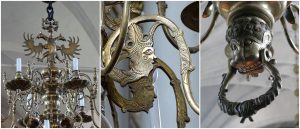Décor motifs of the bronze chandeliers in Lithuania and Latvia in the 16th – 18th century: typology, prevalence, symbolism[1]
Author: Alante Valtaite-Gagac

Please find the article in full here: https://sciendo.com/article/10.2478/mik-2022-0003
Summary:
The article analyses for the first time the décor’ motifs of the bronze chandeliers from Lithuania and Latvia in the 16th – 18th century. The more abundant objects found in Latvia are used to reconstruct the lost heritage of chandeliers in Lithuania, and the variety, origin, and symbolism of décor motifs are analysed. Latvia, which is close to Lithuania, was chosen for the study because of the abundant heritage of bronze chandeliers of the 16th – 18th century and the close political and economic trade relations between the Grand Duchy of Lithuania and Livonia.
The study revealed two groups of décor elements: some of them came from the Gothic and were still used during the Renaissance, while other motifs began to be used together with the beginning of the popularity of cultural antiquity in the 16th century. Based on the surviving examples in Poland, it can be stated that Mariological chandeliers in Lithuania and Latvia may have still existed in the Renaissance. The most archaic zoomorphic motifs of deer and lion’s heads were already used in the Gothic period. Many chandeliers with the latter element have survived in Latvia; therefore, it is probable that they were also present in Lithuania. The Dolphin, frequently found in the décor of chandeliers in the 16th – 17th century, in the art of early Christianity, was considered a symbol of Christ the Saviour. Relatively rare chandeliers in Europe with serpent arms have survived in Lithuania. This polysemantic décor’s symbolism originated from the Netherlands. Lithuanian museums preserve four chandeliers with this décor from the 16th – 17th century. Lots of chandeliers with double-headed eagle have survived in Lithuania and Latvia. They are widespread throughout Europe and could express sympathy or dynastic, administrative relations with any empire. The abundant heritage of chandeliers with this motif in Christian sacral buildings also suggests a broader, sacral meaning for the double-headed eagle. During the Renaissance and later in the Baroque period, chandeliers were started to be decorated with allegorical motifs of antique mythology. One of the most popular gods of ancient Rome was Jupiter. He was associated with the fire element and Heavenly light. Sirens were also a popular element of chandeliers’ décor. In the 16th – 18th century, the uppermost part of the chandeliers were decorated with sculptures of soldiers of various periods, the symbolism of which can be interpreted as the doers of justice and the maintainers of the Divine order on earth. In the 16th – 18th century, bronze chandeliers in Lithuania and Latvia were decorated with figurative décor elements and floral motifs that complement the composition: shoots, buds, or flower blossoms.
The study revealed that the uppermost section of the chandeliers were not decorated in a random manner, but with relevant and important elements that had a symbolic meaning for that period. These could be allegorical motifs of décor symbolising fire/Heavenly light, motifs symbolising Divine order on earth or Divine patronage, as well as heraldic décor elements denoting political relationships or goodwill.
[1] This research is/was funded by the European Social Fund under the No 09.3.3-LMT-K-712-19-0135 “Manufacturing, Development and Survival of Brass Chandeliers in the 16th – 18th Century: Case Studies in Lithuania and Latvia” measure.
No Comments, Comment or Ping
Reply to “Décor motifs of the bronze chandeliers in Lithuania and Latvia in the 16th – 18th century:”